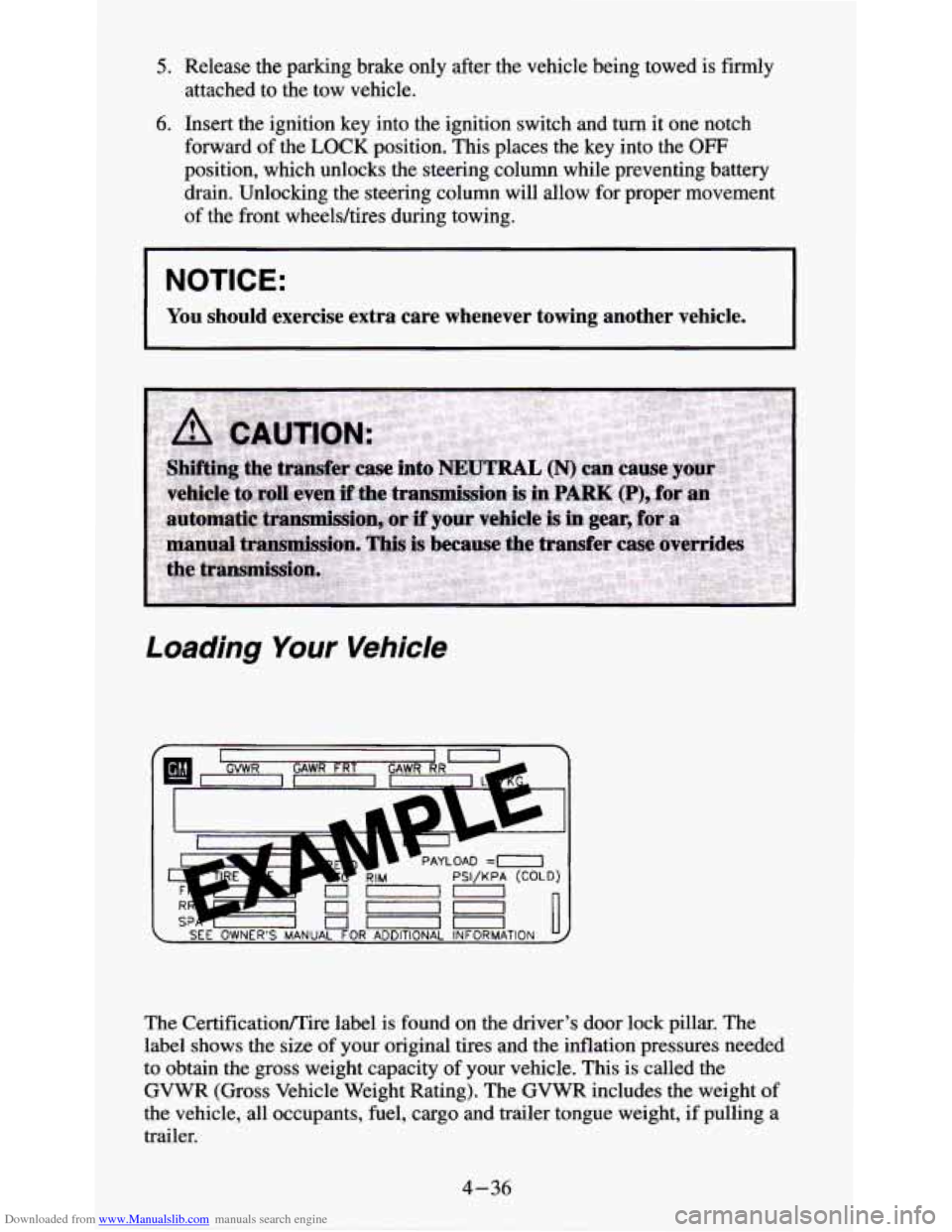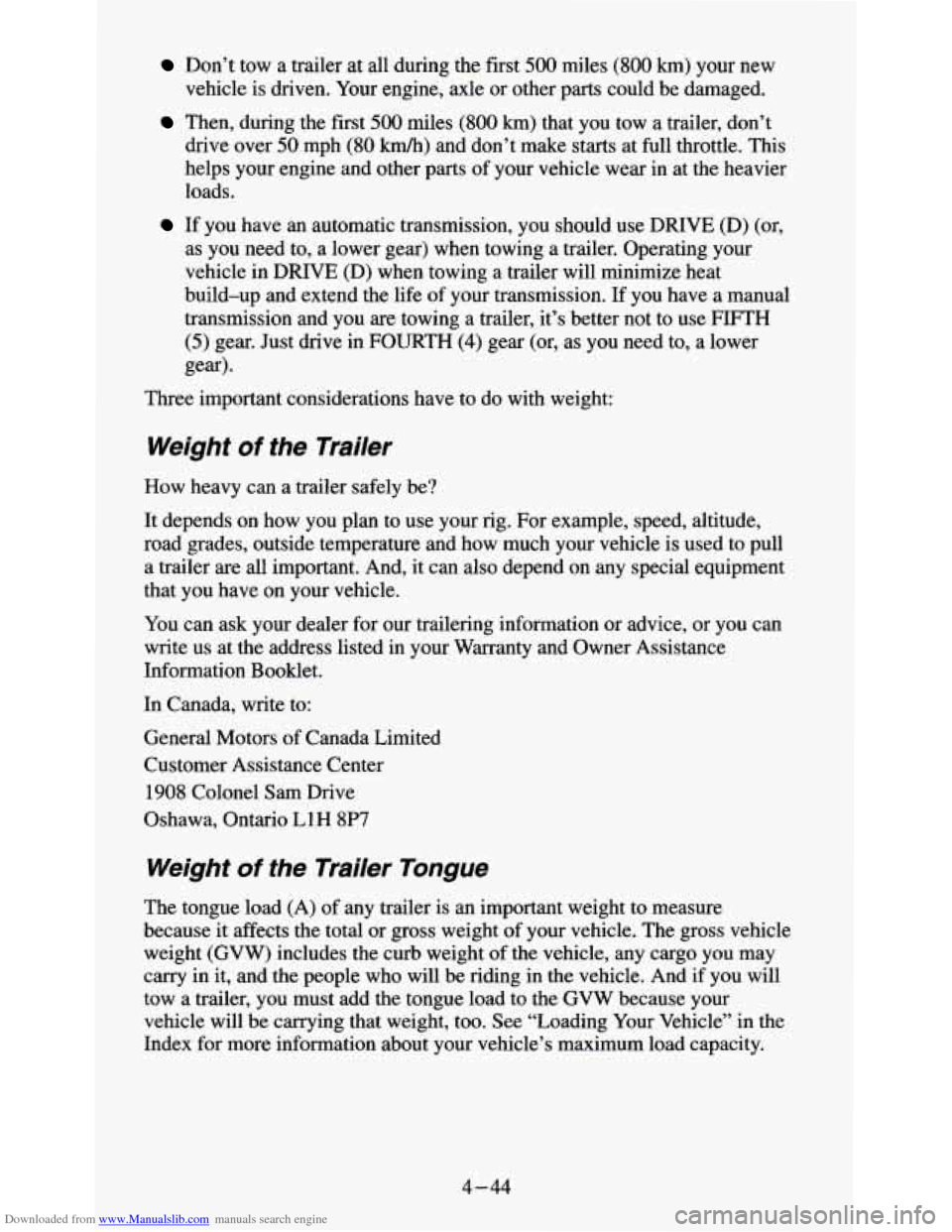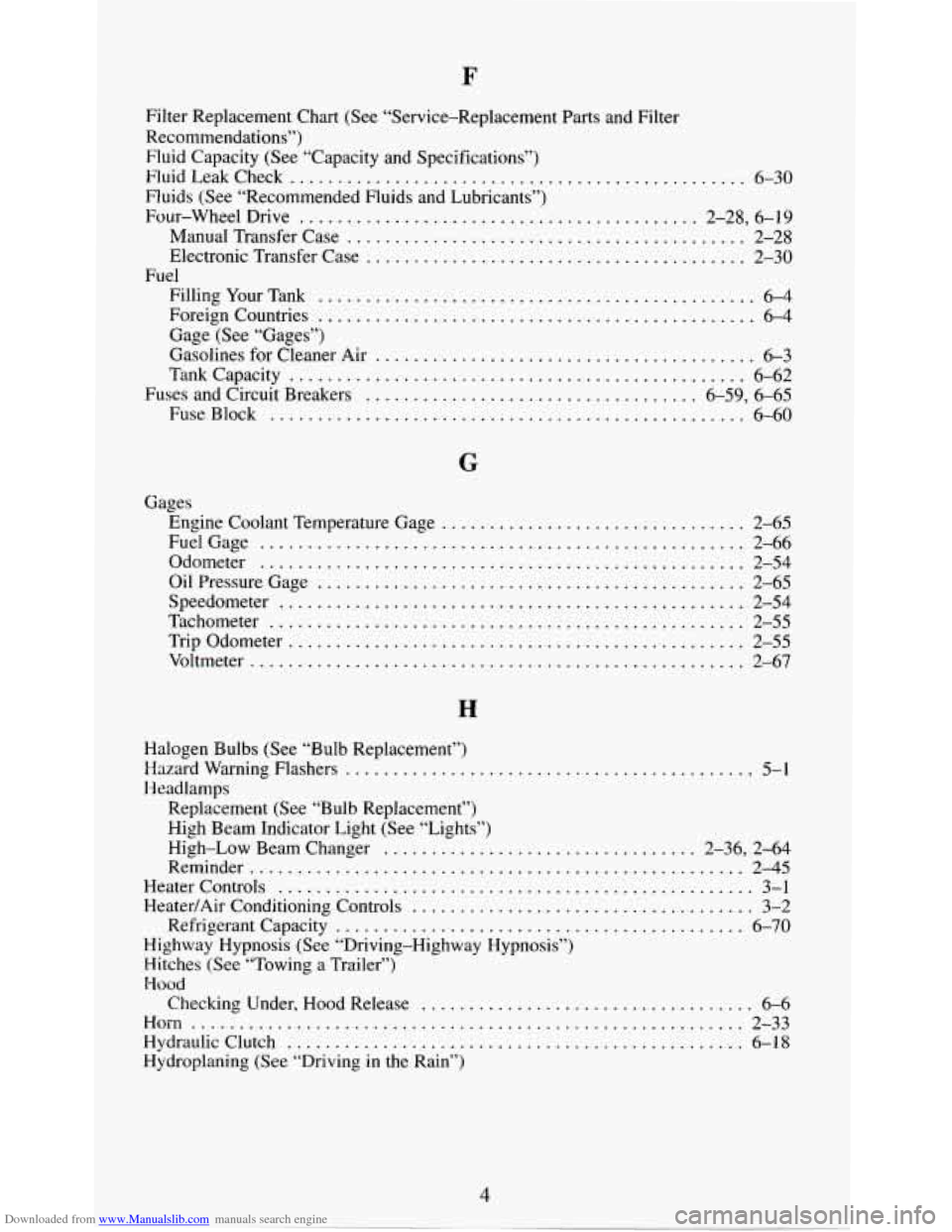towing capacity CHEVROLET S10 1995 2.G Owners Manual
[x] Cancel search | Manufacturer: CHEVROLET, Model Year: 1995, Model line: S10, Model: CHEVROLET S10 1995 2.GPages: 354, PDF Size: 18.92 MB
Page 169 of 354

Downloaded from www.Manualslib.com manuals search engine 5. Release the parking brake only after the vehicle being towed is firmly
attached to the tow vehicle.
6. Insert the ignition key into the ignition switch and turn it one notch
forward of the
LOCK position. This places the key into the OFF
position, which unlocks the steering column while preventing battery
drain. Unlocking the steering column will allow for proper movement
of the front wheelshires during towing.
NOTICE:
You should exercise extra care whenever towing another vehicle.
Loading Your Vehicle
PAYLOAD =I-1
The Certificatioflire label is found on the driver’s door lock pillar. The
label shows the size of your original tires and the inflation pressures needed
to obtain the gross weight capacity of your vehicle. This is called the
GVWR (Gross Vehicle Weight Rating). The GVWR includes the weight of
the vehicle, all occupants, fuel, cargo and trailer tongue weight, if pulling a
trailer.
4-36
Page 177 of 354

Downloaded from www.Manualslib.com manuals search engine Don’t tow a trailer at all during the first 500 miles (800 km) your new
vehicle is driven. Your engine, axle or other parts could be damaged.
Then, during the first 500 miles (800 km) that you tow a trailer, don’t
drive over
50 mph (80 km/h) and don’t make starts at full throttle. This
helps your engine and other parts of your vehicle wear in at the heavier
loads.
If you have an automatic transmission, you should use DRIVE (D) (or,
as you need to, a lower gear) when towing a trailer. Operating your
vehicle
in DRIVE (D) when towing a trailer will minimize heat
build-up and extend the life of your transmission. If you have a manual
transmission and you are towing a trailer, it’s better not to use
FIFTH
(5) gear. Just drive in FOURTH (4) gear (or, as you need to, a lower
gear)-
Three important considerations have to do with weight:
Weight of the Trailer
How heavy can a trailer safely be?
It depends on how you plan to use your rig. For example, speed, altitude,
road grades, outside temperature and how much your vehicle is used to pull
a trailer are all important. And, it can also depend on any special equipment
that you have on your vehicle.
You can ask your dealer for our trailering information
or advice, or you can
write us at the address listed in your Warranty and Owner Assistance
Information Booklet.
In Canada, write to:
General Motors of Canada Limited
Customer Assistance Center
1908 Colonel Sam Drive
Oshawa, Ontario L1H
8P7
Weight of the Trailer Tongue
The tongue load (A) of any trailer is an important weight to measure
because it affects the total or gross weight of your vehicle. The gross vehicle
weight (GVW) includes the curb weight of the vehicle, any cargo you may
carry in it, and the people who will be riding in the vehicle. And if you will
tow a trailer, you must add the tongue load to the GVW because your
vehicle will be carrying that weight, too. See “Loading Your Vehicle” in the
Index for more information about your vehicle’s maximum load capacity.
4-44
Page 347 of 354

Downloaded from www.Manualslib.com manuals search engine F
Filter Replacement Chart (See “Service-Replacement Parts and Filter
Recommendations”)
Fluid Capacity (See “Capacity and Specifications”)
l;luidLeakCheck
................................................ 6-30
Fluids (See “Recommended Fluids and Lubricants”)
Four-wheel Drive
.......................................... 2-28. 6-19
Manual Transfer Case
.......................................... 2-28
Electronic Transfer Case
........................................ 2-30
FillingYourTank
.............................................. 6-4
Foreign Countries .............................................. 6-4
Gage (See “Gages”)
Gasolines for Cleaner Air
.................................... 6-3
Tankcapacity
................................................ 6-62
Fuses and Circuit Breakers
................................... 6-59, 6-65
Fuel
FuseBlock .................................................. 6-60
G
Gages
Engine Coolant Temperature Gage
................................ 2-65
FuelGage
................................................... 2-66
Odometer
................................................... 2-54
OilPressureGage
............................................. 2-65
Tachometer
.................................................. 2-55
Voltmeter
.................................................... 2-67
Speedometer
................................................. 2-54
Trip Odometer
................................................ 2-55
.............. 5-1
Halogen Bulbs (See “Bulb Replacement”)
Headlamps Hazard Warning Flashers
...........................
Replacement (See “Bulb Replacement”)
High Beam
Indicator Light (See “Lights”)
High-Low Beam Changer
................................. 2.36, 2.64
Reminder
.................................................... 2-45
Heater Controls
.................................................. 3-1
Heater/Air Conditioning Controls
.................................... 3-2
Refrigerant Capacity
........................................... 6-70
Highway Hypnosis (See “Driving-Highway Hypnosis”)
Hitches (See “Towing a Trailer”)
Wood
Horn ......................................... ............. 2-33
HydraulicClutch
................................................ 6-18
Hydroplaning (See “Driving in the Rain”)
Checking
Under, Hood Release
................................... 6-6
4